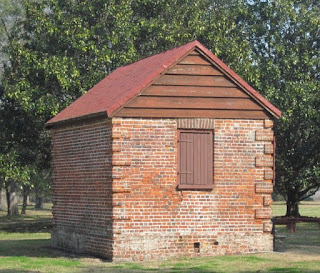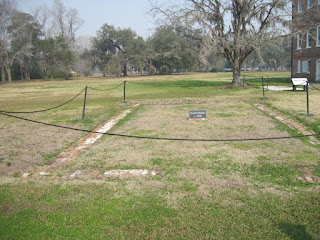 The front of the historic sign indicates this plantation house is the only one along the Ashley River that has survived. That's it architecture is that of Georgian Palladian. The nature of that architecture is that the house inside and outside is balanced. What is to the right of door for example visually appears to be the same as that on left. If a bookcase or fireplace is a room with a shelf or window or one side, you'll find the same feature on the other.
The front of the historic sign indicates this plantation house is the only one along the Ashley River that has survived. That's it architecture is that of Georgian Palladian. The nature of that architecture is that the house inside and outside is balanced. What is to the right of door for example visually appears to be the same as that on left. If a bookcase or fireplace is a room with a shelf or window or one side, you'll find the same feature on the other. Side 2 of the sign talks about how grand, the Drayton families were. That William Henry (1742-1779) was a Revolutionary War Patriot, and Chief Justice in South Carolina, and a member of The Continental Congress. A person who fought for his rights, a person who fought to be free of someone else's control. It goes on to tell us Dr. Charles Drayton (1743-1822) was Lt. Governor, and John Drayton (1767-1822) was Governor of the State of South Carolina. Well yes, on the surface this would seem to be quite a family. It does not tell us about the huge number of slaves they owned. I personally found it ironic that a family who fought for their own freedoms, from the control of others would ignore the rights of others, and not only control them...as England tried to control the colonies; but buy and sell them and hold them in bondage.
Side 2 of the sign talks about how grand, the Drayton families were. That William Henry (1742-1779) was a Revolutionary War Patriot, and Chief Justice in South Carolina, and a member of The Continental Congress. A person who fought for his rights, a person who fought to be free of someone else's control. It goes on to tell us Dr. Charles Drayton (1743-1822) was Lt. Governor, and John Drayton (1767-1822) was Governor of the State of South Carolina. Well yes, on the surface this would seem to be quite a family. It does not tell us about the huge number of slaves they owned. I personally found it ironic that a family who fought for their own freedoms, from the control of others would ignore the rights of others, and not only control them...as England tried to control the colonies; but buy and sell them and hold them in bondage. This is the front view of the large plantation house. Notice the number of windows on each side of the door, the stairs lending up both sides. The balance of the design.
This is the front view of the large plantation house. Notice the number of windows on each side of the door, the stairs lending up both sides. The balance of the design. A side view gives you a feel for the depth and size of this house. This was indeed a grand house that would have been surrounding with out buildings, slave quarters, crops and the like.
A side view gives you a feel for the depth and size of this house. This was indeed a grand house that would have been surrounding with out buildings, slave quarters, crops and the like. And speaking of out buildings.
And speaking of out buildings. Notice again the balance with a doorway on each side of the fire place. The family crest above the fireplace. There were examples in the house where a door might not have been a door, but appeared to be by the way it way painted and the molding etc....this might have been one.
Notice again the balance with a doorway on each side of the fire place. The family crest above the fireplace. There were examples in the house where a door might not have been a door, but appeared to be by the way it way painted and the molding etc....this might have been one.  A magnificent tree. It was quite large with moss hanging down. Here it looks rather eery due to very bad smoke the day we were there; due to forest fires in the area.
A magnificent tree. It was quite large with moss hanging down. Here it looks rather eery due to very bad smoke the day we were there; due to forest fires in the area. Beautiful details even on the ceiling.
Beautiful details even on the ceiling. Excavation has taken place and plenty more scheduled. This plantation, is a preservation project , not a restoration project. There are 2 distinct schools of thought on learning history from historic areas/houses etc. Preservationists believe things should not be rebuilt, as rebuilding focuses on one time in history. They believe letting something stay in it's natural state is more of a living history. Personally, I disagree. I would rather have seen this place restored, to see it in all it's grandeur. The grandeur is what demanded the use of slaves, and as that was it's peak time, it's place in history such a vital part of our country; I'm not sure what happened to the house afterwards is of much interest. So, one family changed a color in a room, or added shelves or took out a wall...that seems insignificant to me. But, to see this house as it was, with period furnishes would have been a marvel to me
Excavation has taken place and plenty more scheduled. This plantation, is a preservation project , not a restoration project. There are 2 distinct schools of thought on learning history from historic areas/houses etc. Preservationists believe things should not be rebuilt, as rebuilding focuses on one time in history. They believe letting something stay in it's natural state is more of a living history. Personally, I disagree. I would rather have seen this place restored, to see it in all it's grandeur. The grandeur is what demanded the use of slaves, and as that was it's peak time, it's place in history such a vital part of our country; I'm not sure what happened to the house afterwards is of much interest. So, one family changed a color in a room, or added shelves or took out a wall...that seems insignificant to me. But, to see this house as it was, with period furnishes would have been a marvel to me A small gift shop/museum is on the grounds.
A small gift shop/museum is on the grounds. Looking up to the 2nd story. Again...balance, details in the stairs and the walls.
Looking up to the 2nd story. Again...balance, details in the stairs and the walls. Difficult o see, but if you click to enlarge and look where the Guides finger is pointing, you'll see a growth chart. Every year the family's children would measure up.
Difficult o see, but if you click to enlarge and look where the Guides finger is pointing, you'll see a growth chart. Every year the family's children would measure up. Another view of the staircase. Can't you see someone in a fine gown decending...making their appearance as the quest looked up?
Another view of the staircase. Can't you see someone in a fine gown decending...making their appearance as the quest looked up? Though the older generations don't appear to be buried on property there is a small circular grave area. Only 2 burials appear to be here, that of Mary Jervey Drayton (July 13, 1920 through March 22, 2006), and John Garrnett Nelson (March 11, 1939 through Dec 8th, 1999). Obviously these are very recent burials. The hope is that these later generations will have a place at The Drayton Home. The center stone reads Haciter Ad Astra, which was the family motto, meaning; "this way to the stars".
Though the older generations don't appear to be buried on property there is a small circular grave area. Only 2 burials appear to be here, that of Mary Jervey Drayton (July 13, 1920 through March 22, 2006), and John Garrnett Nelson (March 11, 1939 through Dec 8th, 1999). Obviously these are very recent burials. The hope is that these later generations will have a place at The Drayton Home. The center stone reads Haciter Ad Astra, which was the family motto, meaning; "this way to the stars". A model showing 2 additional buildings exists. One of these building footprint is marked from the excavations.
A model showing 2 additional buildings exists. One of these building footprint is marked from the excavations. The plantation became part of a National Trust in 1974.
It was very interesting, and I do recommend the tours for adults; definitely not for small children. There's lots of talking and no one is permitted to touch anything, or sit down. Standing still and listening would be very difficult for children. There's also a rather heavy push for contributions to the cause at the end of the tour. I'm all for honoring and remembering history, and giving people the opportunity to participate via contributions. But, you see the sign about that as you drive in; it's on your ticket, and your pamphlet, signs in the gift shop...and so the push at the end of the tour seemed a bit over bearing to my way of thinking.
That was a great post with beautiful photos. I love the pic of that big, old and magnificent tree and a trip to this place seems to be very interesting.
ReplyDeleteI love Charleston but admit to not having spent much time exploring. Thanks for all the posts about the destination.
ReplyDeletehi sandy. thanks for sharing all those pics in this post. i feel like I've already visited the place by just looking at the photos. i haven't been to south carolina. maybe someday!
ReplyDeleteYour site is really good and the posts are just wonderful. Thank you and keep doing your great work.
ReplyDelete